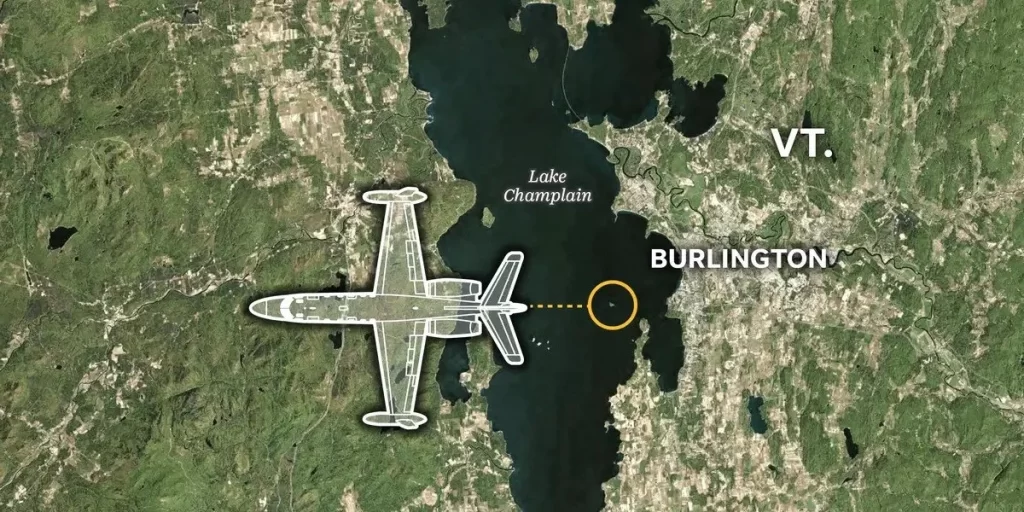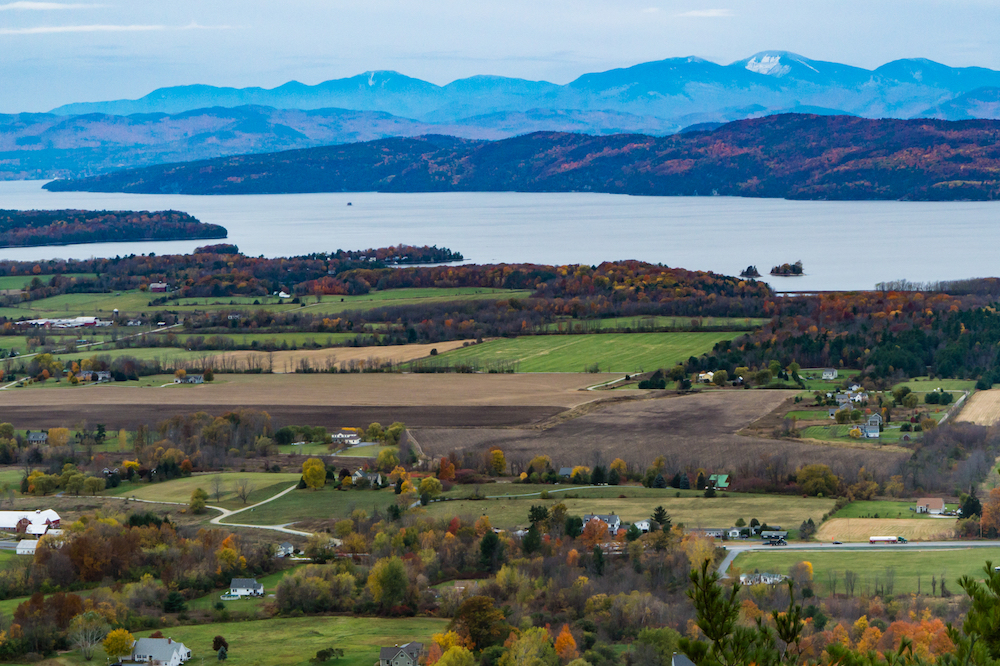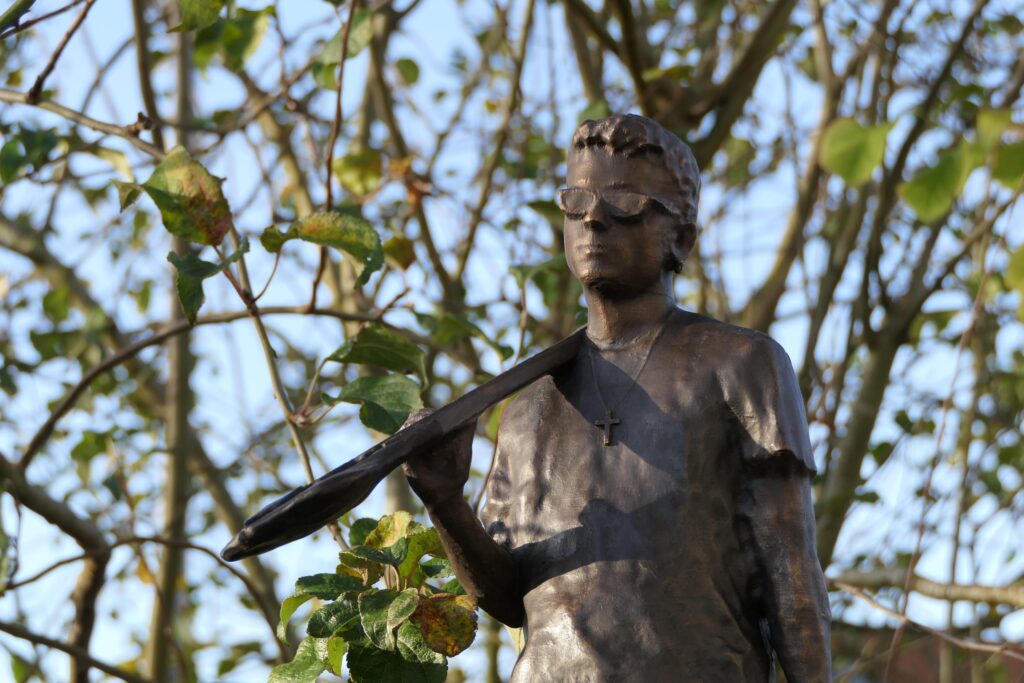The Vanishing and Rediscovery of a Small Jet in Vermont
The Mysterious Disappearance
Fifty-three years ago, on January 27, 1971, a small passenger jet took off from Burlington, Vermont, and vanished without a trace. This Rockwell 1121 Jet Commander, with a registry number of N400CP, was en route to Providence, Rhode Island, carrying five passengers: two crew members and three employees from Cousins Properties, a real estate firm based in Atlanta.
Initial Search Efforts
The jet departed Burlington airport around 8 p.m. on a snowy evening. Shortly after takeoff, it made a turn over Lake Champlain and disappeared from radar screens. Despite the absence of any mayday or emergency signals, flight controllers suspected the aircraft had crashed into the lake. Immediate search efforts were thwarted by rapidly freezing temperatures, which caused the lake to ice over.
Early Discoveries and Continued Searches
In the spring of 1972, after some of the ice had melted, searchers found pieces of the aircraft near Shelburne Point. However, follow-up searches yielded no further evidence. Despite more than 17 search attempts between 1971 and 2014, including increasingly sophisticated technology and methods, the jet remained elusive.
The Search Resumes
In 2022, a new effort was launched to locate the missing jet. Undersea sonar expert Garry Kozak , who had been following the case since the 1980s, spearheaded the search. Kozak collaborated with Hans Hug and Bruce Stebbins, using data from previous low-resolution lakebed scans to pinpoint possible locations. Their initial dives were unsuccessful, but they remained undeterred.
Breakthrough with Advanced Technology
Using an advanced remotely operated vehicle (ROV) provided by Sonar Search and Recovery, the team conducted a detailed sonar survey of the lake floor. The EdgeTech 4125-P side scan sonar system revealed a promising debris field west of Juniper Island, about three miles from Burlington. On May 19, 2022, Kozak and Hug identified a large debris field that appeared to be a jet aircraft crash site.
Confirming the Discovery
To confirm the discovery, the team used the ROV to capture real-time video footage of the wreckage. The images showed a broken fuselage with the distinctive white paint and red and black accents of the missing Jet Commander. Nearby, they found the remains of two turbine jet engines and a broken wing. Kozak was confident they had found the right plane.
Impact on the Families
The discovery brought mixed emotions to the families of the victims. Barbara Nikitas, niece of pilot George Nikita, expressed a sense of both peace and sadness. Frank Wilder, whose father was on the jet, shared similar sentiments. The resolution of the mystery provided some closure but also reopened old wounds and raised new questions.
National Transportation Safety Board’s Role
The National Transportation Safety Board (NTSB) plans to examine the newly found debris. The agency, in collaboration with the Federal Aviation Administration (FAA), will determine the wreckage’s condition and the degree of certainty in linking it to the missing jet. Kozak has shared the exact coordinates of the debris field with the families but has kept the location confidential out of respect.
Conclusion: A Mystery Solved, But Questions Remain
The rediscovery of the Jet Commander after 53 years marks a significant milestone in aviation history. While the families of the victims now have answers about the fate of their loved ones, the cause of the crash remains undetermined. The NTSB’s upcoming examination may provide further insights, but for now, the mystery of why the jet crashed on that snowy night in 1971 endures.
The Disappearance of N400CP
On a cold and snowy January evening in 1971, a small passenger jet took off from Burlington, Vermont, heading towards Providence, Rhode Island. The 10-seat Rockwell 1121 Jet Commander, with registry number N400CP, carried five passengers, including two crew members and three employees from Cousins Properties, a real estate firm based in Atlanta. Shortly after takeoff, the plane vanished from radar screens, sparking an intense search effort.
Immediate Search Efforts Thwarted by Winter
The initial search efforts were hampered by the harsh winter conditions. As temperatures dropped, Lake Champlain froze over, preventing authorities from conducting a thorough search. Months later, when the ice began to melt, searchers found debris from the plane near Shelburne Point. However, despite numerous attempts over the following decades, the aircraft remained lost.
Advanced Technology Resumes the Search
In 2022, Garry Kozak, an undersea sonar expert, renewed efforts to locate the missing jet. Kozak teamed up with researchers Hans Hug and Bruce Stebbins, using previous lakebed scans to identify potential search areas. Employing a remotely operated vehicle (ROV) and the EdgeTech 4125-P side scan sonar system, the team conducted a detailed survey of the lake floor.
Breakthrough Discovery
On May 19, 2022, Kozak and Hug discovered a large debris field west of Juniper Island, approximately three miles from Burlington. The ROV captured images of a broken plane fuselage with the same paint scheme as the missing Jet Commander. Nearby, the remains of two turbine jet engines and a broken wing confirmed the identity of the aircraft.
Mixed Emotions for Families
The discovery brought a range of emotions for the families of the victims. Barbara Nikitas, niece of pilot George Nikita, described feeling both peace and sadness. Frank Wilder, whose father was on the jet, shared similar sentiments. While the discovery provided some closure, it also reopened old wounds and raised new questions.
The Role of the National Transportation Safety Board
The National Transportation Safety Board (NTSB) plans to examine the newly found debris to determine its condition and confirm its identity. Kozak has shared the exact coordinates of the debris field with the families but has kept the location confidential out of respect for the victims.
Conclusion: Solving a Decades-Old Mystery
The discovery of the Jet Commander after 53 years marks a significant milestone in aviation history. While the cause of the crash remains unknown, the families of the victims now have some answers. The NTSB’s examination may provide further insights, but for now, the mystery of why the jet crashed on that snowy night in 1971 endures.
Conclusion: A Dramatic Resolution to a Half-Century Mystery
The rediscovery of the Rockwell 1121 Jet Commander, known by its registry number N400CP, marks the dramatic end to a mystery that has haunted the annals of aviation history for more than half a century. On that fateful January night in 1971, as snow fell thickly over Vermont, the small jet took off from Burlington, destined for Providence, Rhode Island. It was a routine flight with five souls on board—two crew members and three employees from Cousins Properties. Yet, shortly after takeoff, the jet vanished into the abyss, leaving behind nothing but questions and heartbreak.
The immediate aftermath of the disappearance was marked by frantic but ultimately futile search efforts. The snowy landscape of Vermont and the freezing waters of Lake Champlain conspired against rescuers, turning the lake into an impenetrable icy tomb. For the families of those on board, the long winter months stretched into years, each passing season bringing a mix of hope and despair as search teams scoured the lakebed to no avail. Pieces of the aircraft surfaced sporadically, tantalizingly close yet never enough to provide closure.
Years turned into decades, and the story of the missing jet became a somber chapter in aviation history. Advanced search technologies came and went, each promising resolution but ultimately failing to pierce the veil of mystery that shrouded N400CP. The case, which had long gone cold, seemed destined to remain an unsolved enigma.
Then, in 2022, a new chapter began. Garry Kozak, an undersea sonar expert with a lifelong fascination for the case, spearheaded a renewed search. Partnering with fellow researchers Hans Hug and Bruce Stebbins, Kozak employed cutting-edge technology to conduct a detailed sonar survey of Lake Champlain’s floor. Their efforts were nothing short of heroic, driven by a relentless pursuit of truth and a desire to bring peace to the families of the lost.
On May 19, 2022, after meticulous scanning and diving, the team made a breakthrough. A promising debris field was discovered west of Juniper Island, only three miles from Burlington. Real-time video footage captured by an advanced remotely operated vehicle (ROV) confirmed the identity of the wreckage. The distinctive white paint with red and black accents, the turbine jet engines, the broken wing—it all pointed unmistakably to the long-lost Jet Commander.
The discovery brought a rush of mixed emotions. For the families, it was a bittersweet moment. Barbara Nikitas, niece of pilot George Nikita, spoke of a profound sense of peace mingled with deep sadness. Frank Wilder, whose father was on the jet, echoed these sentiments. While the discovery provided some closure, it also reopened old wounds and stirred new questions. Why had the jet crashed? What transpired in those final moments? The answers remained elusive.
The National Transportation Safety Board (NTSB), in collaboration with the Federal Aviation Administration (FAA), has taken on the task of examining the debris. Their investigation will seek to uncover the causes of the crash, potentially offering final answers to the lingering questions. Kozak, ever respectful of the victims and their families, has kept the exact coordinates of the crash site confidential.
The rediscovery of N400CP stands as a testament to human perseverance and the relentless quest for truth. It closes a chapter in aviation history while leaving the final page unwritten. The mystery of why the jet crashed on that snowy night in 1971 may endure, but the rediscovery brings a measure of peace and resolution. It is a poignant reminder of the fragility of life and the enduring strength of the human spirit.
Opening Old Wounds and Unanswered Questions
The recent discovery of the Rockwell 1121 Jet Commander, lost since January 27, 1971, in the frigid skies above Burlington, Vermont, has brought a complex mix of relief and renewed anguish for the families of the victims. While the confirmation of the aircraft’s location ends a decades-long quest for answers, it also opens a new chapter filled with unresolved questions and reopened emotional scars.
“To have this found now… it’s a peaceful feeling, at the same time it’s a very sad feeling,” expressed Barbara Nikitas, niece of the pilot George Nikita, in a heartfelt interview with The Associated Press. “We know what happened. We’ve seen a couple of photos. We’re struggling, I think, with that now.”
For Frank Wilder, whose father was among the passengers, the discovery brings a bittersweet sense of closure. “Spending 53 years not knowing if the plane was in the lake or maybe on a mountainside around there somewhere was distressing,” Wilder, who resides near Philadelphia, reflected. “And again, I’m feeling relieved that I know where the plane is now but unfortunately it’s opening other questions and we have to work on those now.”
A Long and Frustrating Search
When the ice melted in the spring of 1971, initial signs of the aircraft surfaced near Shelburne Point. However, an underwater search conducted that May yielded no further evidence. Over the ensuing decades, at least 17 additional searches were conducted, including a notable effort in 2014 spurred by advancements in search technology following the disappearance of Malaysia Airlines Flight 370. Despite the high hopes, those searches, too, ended in disappointment.
The persistence and dedication of undersea sonar expert Garry Kozak have been instrumental in this renewed effort. After the 2014 search proved unsuccessful, Kozak’s curiosity was piqued. He meticulously examined a sonar survey of Lake Champlain conducted by the Lake Champlain Maritime Museum and Middlebury College, identifying four anomalies on the lake floor. Despite finding a military aircraft during an initial investigation in 2022, Kozak’s relentless pursuit paid off when a new anomaly pointed to the likely wreckage of N400CP.
Connecting with Fellow Families
Barbara Nikitas and her cousin Kristina Nikita Coffey, daughter of George Nikita, led the charge in reconnecting with other victims’ families. This collaboration proved invaluable. “Everybody had pieces of the pie and the puzzle,” said Charles Williams, whose father, Robert Ransom Williams III, was on the plane. “When we started sharing information and documents, we gained a much greater understanding and perspective of the information and how we were all impacted by this.”
The families collectively expressed profound gratitude towards Kozak. “He is a hero for his dedication to finding the plane,” Williams remarked. Kozak’s recent efforts, aided by Hans Hug of Sonar Search and Recovery and a colleague with an advanced remotely operated vehicle (ROV), culminated in the dramatic discovery last month.
Awaiting Confirmation and Future Steps
The National Transportation Safety Board (NTSB) is now tasked with verifying the wreckage’s identity. While the NTSB does not conduct salvage operations, the decision on whether to disturb the site remains a difficult one. “Whether there are tangible remains, and I hate to say it that way, and worth disturbing, that’s a decision that we’ll have to figure out later, and part of what we’re unpacking now,” Williams explained. “It’s hard when you start to think about that.”
Honoring the Lost
As the investigation continues, the relatives of the victims plan to hold a memorial service, now that they finally know where the plane is located. This gathering will serve as a poignant reminder of the lives lost and the enduring impact of this tragic event.
The rediscovery of the Jet Commander, while providing some answers, underscores the enduring pain and unresolved questions that continue to haunt the families. It is a story of relentless human determination, technological prowess, and the unyielding hope for closure amidst enduring mystery.






